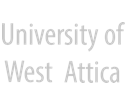Modeling and Transformation of the Evaluation Mechanism of Greek Higher Education Institutes using Balanced Scorecard Technique
Abstract
Keywords
References
Asan S. S. & Tanyas M. (2007), Integrating Hoshin Kanri and the Balanced Scorecard for Strategic Management: The Case of Higher Education, Total Quality Management & Business Excellence, 18:9,999-1014
BOC.AdoScore . http://www.boc-group.com/products/adonis/
Chalaris I., Boursanidis Ch. (2009), Evaluation of a High Educational Institute using the balance scorecard technique- The first experiments from the First experiences with the Dept of Informatics, TEI of Athens, 3rd Conference of Administrative Sciences, University of Crete
Chalaris M., Tsolakidis A., Sgouropoulou C. & Chalaris I. (2011), Developing an Information System for Quality Assurance in Higher Education using the Balanced Scorecard Technique - The case study of TEI-A, PCI 2011. ISBN 978-0-7695-4389-5.DOI 10.1109/ PCI. 2011. 43.
Chalaris I., Poustourli C. (2013) Quality Continuous Improvement in Higher Education with Balance Scorecard Technique proceedings of Management of International Business and Economics Systems, Larissa, Greece
HQAA-Hellenic Quality Assurance Agency for Higher Education. www.hqaa.gr/ or www.hqaa.gr
Kaplan, R.S. and Norton, D.P. (2001), The Strategy-focused Organization, How Balanced Scorecard Companies thrive in the New Business Environment, Harvard Business School Press, Boston, MA.
Kaplan, R.S. and Norton, D.P. (2004), Strategy Maps, Converting the Intangible Assets into Tangible Outcomes, Harvard Business School Press, Boston, MA
Karathanos, D., Karathanos, P. (2005). Applying the Balanced Scorecard to education, Journal of Education for Business, March/April, 222-230.
Kettunen, J., & Kantola, I. (2005). Management information system based on the balanced scorecard. Campus-Wide Information Systems, 22, 263–274
Kettunen, J. (2008). A conceptual framework to help evaluate the quality of institutional performance, Quality Assurance in Education, 16(4), 322-332
Nayeri M. D., Mashhadi M. M. & Mohajeri K. (2008), Universities Strategic Evaluation Using Balanced Scorecard
Umashankar, V., Dutta, K. (2007). Balanced scorecards in managing higher education institutions: an Indian perspective, International Journal of Educational Management, 21(1), 54-67.
DOI: 10.18780/jiim.v2i1.3061
Refbacks
- There are currently no refbacks.






